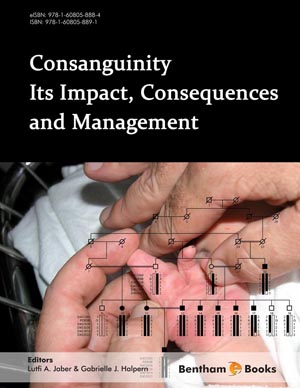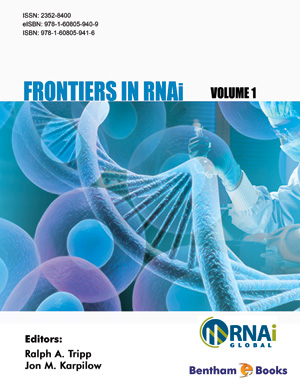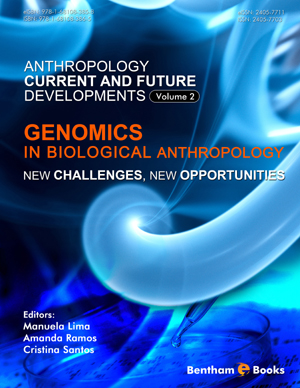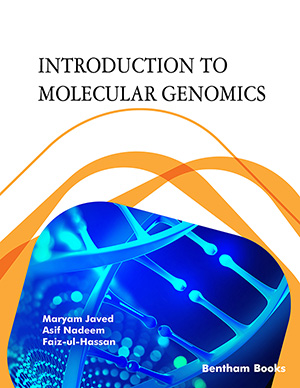Book Volume 1
Endometrial Cancer as a Familial Tumor: Pathology and Molecular Carcinogenesis
Page: 3-14 (12)
Author: Kouji Banno, Megumi Yanokura, Kennta Masuda, Arisa Ueki, Iori Kisu, Yusuke Kobayashi, Wataru Yamagami, Nobuyuki Susumu and Daisuke Aoki
DOI: 10.2174/9781608051298113010004
PDF Price: $30
Abstract
Some cases of endometrial cancer are associated with a familial tumor and are referred to as hereditary nonpolyposis colorectal cancer (HNPCC or Lynch syndrome). Such tumors are thought to be induced by germline mutation of the DNA mismatch repair (MMR) gene, but many aspects of the pathology of familial endometrial cancer are unclear and no effective screening method has been established. However, the pathology of endometrial cancer with familial tumor has been progressively clarified in recent studies. At present, about 0.5% of all cases of endometrial cancers meet the clinical diagnostic criteria for HNPCC. A recent analysis of the three MMR genes (hMLH1, hMSH2 and hMSH6) revealed germline mutations in 18 of 120 cases (15.0%) of endometrial cancer with familial accumulation of cancer or double cancer, with a frameshift mutation of the hMSH6 gene being the most common. Many cases with mutation did not meet the current clinical diagnostic criteria for HNPCC, indicating that familial endometrial cancer is often not diagnosed as HNPCC. The results suggest that the hMSH6 gene mutation may be important in carcinogenesis in endometrial cancer and germline mutations of the MMR gene may be more prevalent in cases associated with familial accumulation of cancer. An international large-scale muticenter study is required to obtain further information about the pathology of endometrial cancer as a familial tumor.
Replication Origins and Timing of Temporal Replication in Budding Yeast: How to Solve the Conundrum?
Page: 15-44 (30)
Author: Matteo Barberis, Thomas W. Spiesser and Edda Klipp
DOI: 10.2174/9781608051298113010005
PDF Price: $30
Abstract
Similarly to metazoans, the budding yeast Saccharomyces cereviasiae replicates its genome with a defined timing. In this organism, well-defined, site-specific origins, are efficient and fire in almost every round of DNA replication. However, this strategy is neither conserved in the fission yeast Saccharomyces pombe, nor in Xenopus or Drosophila embryos, nor in higher eukaryotes, in which DNA replication initiates asynchronously throughout S phase at random sites. Temporal and spatial controls can contribute to the timing of replication such as Cdk activity, origin localization, epigenetic status or gene expression. However, a debate is going on to answer the question how individual origins are selected to fire in budding yeast. Two opposing theories were proposed: the “replicon paradigm” or “temporal program” vs. the “stochastic firing”. Recent data support the temporal regulation of origin activation, clustering origins into temporal blocks of early and late replication. Contrarily, strong evidences suggest that stochastic processes acting on origins can generate the observed kinetics of replication without requiring a temporal order. In mammalian cells, a spatiotemporal model that accounts for a partially deterministic and partially stochastic order of DNA replication has been proposed. Is this strategy the solution to reconcile the conundrum of having both organized replication timing and stochastic origin firing also for budding yeast? In this review we discuss this possibility in the light of our recent study on the origin activation, suggesting that there might be a stochastic component in the temporal activation of the replication origins, especially under perturbed conditions.
The Role of Androgen Receptor Mutations in Progression of Prostate Cancer
Page: 45-65 (21)
Author: G.N. Brooke, J. Waxman and C. L. Bevan
DOI: 10.2174/9781608051298113010006
PDF Price: $30
Abstract
Prostate cancer growth is regulated by the androgen receptor pathway and so therapies to block androgen production and action are commonly used for the treatment of this disease. Although initially successful in the majority of patients, resistance to hormonal therapy generally emerges and patients’ tumours progress to the ‘castrate resistant’ phase, for which few therapeutic options exist. Expression of the androgen receptor is maintained in castrate resistant prostate cancer and there is a significant body of evidence that demonstrates that the androgen receptor is driving growth, even in the androgen-depleted environment. Several mechanisms have been described to explain how the androgen receptor is active under such circumstances and this current review summarises how mutations of the androgen receptor provide a growth advantage through mechanisms that may involve cofactor recruitment, reduced ligand specificity or promoting constitutive activity. Indivividual mutations appear to differentially regulate gene expression, therefore tumours may behave differently dependent upon which mutation is present and which ligand is driving growth.
MUTYH Associated Polyposis (MAP)
Page: 66-100 (35)
Author: M.L.M. Binderup and M.L. Bisgaard
DOI: 10.2174/9781608051298113010007
Abstract
MUTYH Associated Polyposis (MAP) is an autosomal recessive predisposition to polyposis and colorectal cancer (CRC) caused by biallelic mutations in the base excision repair (BER) gene MUTYH. Phenotypically, MAP is difficult to distinguish from other hereditary CRC syndromes like Familial Adenomatous Polyposis (FAP) and to a lesser extent Hereditary Non-Polyposis Colorectal Cancer (HNPCC), known to be caused by germline mutations in the APC and Mismatch Repair (MMR) genes, respectively. Here we review the main genetic and clinical aspects of MAP and aim to provide a broad, up-to-date overview of existing findings regarding MAP.
The exact role of MUTYH in CRC tumorgenesis is not fully determined, but a defective BER system due to germline MUTYH mutations leads to somatic mutations in the APC gene. Furthermore, cooperation between the BER and MMR systems exists, and possibly monoallelic defects in both pathways are of significance to CRC development. The two most common MUTYH variants, Y179C and G396D, both generate dysfunctional gene products, but Y179C has the most severe functional consequences and possibly causes a more severe phenotype.
Median clinical onset of MAP is 47 years of age, and due to the recessive mode of inheritance, most have already developed CRC. Typically MAP patients develop between 10-100 colorectal adenomas, although polyposis may not be obligatory for MAP. Typical FAP and HNPCC associated extracolonic manifestations are not common in MAP, except for upper gastro-duodenal polyposis which can be part of the phenotype, but more seldom than in FAP. Recommended MAP surveillance is colonoscopy with polypectomy from 20-25 years of age. In the future, genetic testing as well as surveillance may be targeted according to specific ethnic MUTYH mutation variants and genotype-phenotype correlations.
Gene Clusters, Molecular Evolution and Disease: A Speculation
Page: 101-145 (45)
Author: Alireza Baradaran-Heravi, Leah I. Elizondo and Cornelius F. Boerkoel
DOI: 10.2174/9781608051298113010008
PDF Price: $30
Abstract
Traditionally eukaryotic genes are considered independently expressed under the control of their promoters and cis-regulatory domains. However, recent studies in worms, flies, mice and humans have shown that genes co-habiting a chromatin domain or “genomic neighborhood” are frequently co-expressed. Often these co-expressed genes neither constitute part of an operon nor function within the same biological pathway. The mechanisms underlying the partitioning of the genome into transcriptional genomic neighborhoods are poorly defined. However, cross-species analyses find that the linkage among the co-expressed genes of these clusters is significantly conserved and that the expression patterns of genes within clusters have co-evolved with the clusters. Such selection could be mediated by chromatin interactions with the nuclear matrix and long-range remodeling of chromatin structure. In the context of human disease, we propose that dysregulation of gene expression across genomic neighborhoods will cause highly pleiotropic diseases. Candidate genomic neighborhood diseases include the nuclear laminopathies, chromosomal translocations and genomic instability disorders, imprinting disorders of errant insulator function, syndromes from impaired cohesin complex assembly, as well as diseases of global covalent histone modifications and DNA methylation. The alteration of transcriptional genomic neighborhoods provides a model for studying epigenetic alterations as quantitative traits in complex common human diseases.
Expression and Function of Kruppel Like-Factors (KLF) in Carcinogenesis
Page: 146-168 (23)
Author: Diab Thoria, Bureau Christophe, Hanoun Naima, Torrisani Jérôme, Vinel Jean-Pierre, Buscail Louis and Cordelier Pierre
DOI: 10.2174/9781608051298113010009
PDF Price: $30
Abstract
Krüppel-like factor (KLF) family members share a three C2H2 zinc finger DNA binding domain, and are involved in cell proliferation and differentiation control in normal as in pathological situations. Studies over the past several years support a significant role for this family of transcription factors in carcinogenesis. KLFs can both activate and repress genes that participate in cell-cycle regulation. Among them, many up-regulated genes are inhibitors of proliferation, whereas genes that promote cell proliferation are repressed. However, several studies do present KLFs as positive regulator of cell proliferation. KLFs can be deregulated in multiple cancers either by loss of heterozygosity (LOH), somatic mutation or transcriptional silencing by promoter hypermethylation. Accordingly, KLF mediates growth inhibition when ectopically expressed in multiple cancer-derived cell lines through the inhibition of a number of key oncogenic signalling pathways, and to reverse the tumorogenic phenotype in vivo. Taken together, these observations suggest that KLFs act as tumor suppressor. However, in some occasion, KLFs could act as tumor promoters, depending on “cellular context”. Thus, this review will discuss the roles and the functions of KLF family members in carcinogenesis, with a special focus on cancers from epithelial origin.
Episcopic 3D Imaging Methods: Tools for Researching Gene Function
Page: 169-188 (20)
Author: Wolfgang J. Weninger and Stefan H. Geyer
DOI: 10.2174/9781608051298113010010
PDF Price: $30
Abstract
This work aims at describing episcopic 3D imaging methods and at discussing how these methods can contribute to researching the genetic mechanisms driving embryogenesis and tissue remodelling, and the genesis of pathologies. Several episcopic 3D imaging methods exist. The most advanced are capable of generating high-resolution volume data (voxel sizes from 0.5x0.5x1μm3 upwards) of small to large embryos of model organisms and tissue samples. Beside anatomy and tissue architecture, gene expression and gene product patterns can be three dimensionally analyzed in their precise anatomical and histological context with the aid of whole mount in situ hybridization or whole mount immunohistochemical staining techniques. Episcopic 3D imaging techniques were and are employed for analyzing the precise morphological phenotype of experimentally malformed, randomly produced, or genetically engineered embryos of biomedical model organisms. It has been shown that episcopic 3D imaging also fits for describing the spatial distribution of genes and gene products during embryogenesis, and that it can be used for analyzing tissue samples of adult model animals and humans. The latter offers the possibility to use episcopic 3D imaging techniques for researching the causality and treatment of pathologies or for staging cancer. Such applications, however, are not yet routine and currently only preliminary results are available. We conclude that, although episcopic 3D imaging is in its very beginnings, it represents an upcoming methodology, which in short terms will become an indispensable tool for researching the genetic regulation of embryo development as well as the genesis of malformations and diseases.
Drosophila Lethal Giant Larvae Neoplastic Mutant as a Genetic Tool for Cancer Modelling
Page: 189-209 (21)
Author: Francesca Froldi, Marcello Ziosi, Annalisa Pession and Daniela Grifoni
DOI: 10.2174/9781608051298113010011
PDF Price: $30
Abstract
Drosophila lethal giant larvae (lgl) is a tumour suppressor gene whose function in establishing apical-basal cell polarity as well as in exerting proliferation control in epithelial tissues is conserved between flies and mammals. Individuals bearing lgl null mutations show a gradual loss of tissue architecture and an extended larval life in which cell proliferation never ceases and no differentiation occurs, resulting in prepupal lethality. When tissues from those individuals are transplanted into adult normal recipients, a subset of cells, possibly the cancer stem cells, are able to proliferate and migrate to distant sites forming metastases which eventually kill the host. This phenotype closely resembles that of mammalian epithelial cancers, in which loss of cell polarity is one of the hallmarks of a malignant, metastatic behaviour associated with poor prognosis. Lgl protein shares with its human counterpart Human giant larvae-1 (Hugl-1) significant stretches of sequence similarity that we demonstrated to translate into a complete functional conservation, pointing out a role in cell proliferation control and tumourigenesis also for the human homologue. The functional conservation and the power of fly genetics, that allows the researcher to manipulate the fly genome at a level of precision that exceeds that of any other multicellular genetic system, make this Drosophila mutant a very suitable model in which to investigate the mechanisms underlying epithelial tumour formation, progression and metastatisation. In this review, we will summarise the results obtained in the last years using this model for the study of cancer biology. Moreover, we will discuss how recent advances in developmental genetics techniques have succeeded in enhancing the similarities between fly and human tumourigenesis, giving Drosophila a pivotal role in the study of such a complex genetic disease.
Genetic Insights Through Genome Wide Association Studies in Type 2 Diabetes Mellitus will Lead to New Therapeutics
Page: 210-240 (31)
Author: Marcel G. M. Wolfs, Naishi Li, Jingyuan Fu, Cisca Wijmenga, Timon W. van Haeften and Marten H. Hofker
DOI: 10.2174/9781608051298113010012
PDF Price: $30
Abstract
Type 2 diabetes is a disorder of dysregulated glucose homeostasis. Normal glucose homeostasis is a complex process involving several interacting mechanisms, such as insulin secretion, insulin sensitivity, glucose production, and glucose uptake. The dysregulation of one or more of these mechanisms due to environmental and/or genetic factors, can lead to a defective glucose homeostasis. Hyperglycemia is managed by augmenting insulin secretion and/or interaction with hepatic glucose production, as well as by decreasing dietary caloric intake and raising glucose metabolism through exercise. Although these interventions can delay disease progression and correct blood glucose levels, they are not able to cure the disease or stop its progression entirely. Better management of type 2 diabetes is sorely needed. Advances in genotyping techniques and the availability of large patient cohorts have made it possible to identify common genetic variants associated with type 2 diabetes through genome-wide association studies (GWAS). So far, genetic variants on 50 loci have been identified. Most of these loci contain or lie close to genes that were not previously linked to diabetes and they may thus harbor targets for new drugs. It is also hoped that further genetic studies will pave the way for predictive genetic screening. The newly discovered candidate genes for type 2 diabetes can be classified based on their presumed molecular function, and we discuss the relation between these gene classes and current treatments. We go on to consider whether the new genes provide opportunities for developing alternative drug therapies.
Indispensable Roles of Plastids in Arabidopsis thaliana Embryogenesis – Update
Page: 241-260 (20)
Author: Mehdi Nafati and Kentaro Inoue
DOI: 10.2174/9781608051298113010013
PDF Price: $30
Abstract
The plastid is an organelle vital to all photosynthetic and some nonphotosynthetic eukaryotes. Although the plastid has its own genome, more than 95% of proteins in this organelle are encoded in the nucleus, representing slightly lower than 10% of all the nuclear-encoded proteins in the model plant Arabidopsis thaliana. Recent functional genomic and molecular genetic studies have shown that ca. 400 nonredundant nuclear genes are required for proper embryo formation of A. thaliana, and that more than one third of them encode plastid-localized proteins. Classification of these genes based on terminal phenotypes of knockout mutants has revealed that nonphotosynthetic metabolic activity of plastids is a prerequisite for the transition of preglobular to globular embryos, and that plastid gene expression becomes significant at or after the globular stage. Functions of the products of 28 out of 105 genes shown to be required for embryo development at the globular and later stages remain unknown. Several approaches to address this issue are discussed.
Mass Spectrometry-Based Approaches Toward Absolute Quantitative Proteomics
Page: 261-292 (32)
Author: Keiji Kito and Takashi Ito
DOI: 10.2174/9781608051298113010014
PDF Price: $30
Abstract
Mass spectrometry has served as a major tool for the discipline of proteomics to catalogue proteins in an unprecedented scale. With chemical and metabolic techniques for stable isotope labeling developed over the past decade, it is now routinely used as a method for relative quantification to provide valuable information on alteration of protein abundance in a proteome-wide scale. Recently, absolute or stoichiometric quantification of proteome is becoming feasible, in particular, with the development of strategies with isotope-labeled standards composed of concatenated peptides. On the other hand, remarkable progress has been also made in label-free quantification methods based on the number of identified peptides. Here we review these mass spectrometry-based approaches for absolute quantification of proteome and discuss their implications.
Regulation of Interactions with Sliding Clamps During DNA Replication and Repair
Page: 293-315 (23)
Author: Francisco J. López de Saro
DOI: 10.2174/9781608051298113010015
PDF Price: $30
Abstract
The molecular machines that replicate the genome consist of many interacting components. Essential to the organization of the replication machinery are ring-shaped proteins, like the prokaryotic β-clamp or eukaryotic PCNA (Proliferating Cell Nuclear Antigen), collectively named sliding clamps. They encircle the DNA molecule and slide on it freely and bidirectionally. Sliding clamps are typically associated to DNA polymerases and provide these enzymes with the processivity required to synthesize large chromosomes. Additionally, they interact with a large array of proteins that perform enzymatic reactions on DNA, targeting and orchestrating their functions. In recent years there have been a large number of studies that have analyzed the structural details of how sliding clamps interact with their ligands. However, much remains to be learned in relation to how these interactions are regulated to occur coordinately and sequentially. Since sliding clamps participate in reactions in which many different enzymes bind and then release from the clamp in an orchestrated way, it is critical to analyze how these changes in affinity take place. In this review I focus the attention on the mechanisms by which various types of enzymes interact with sliding clamps and what is known about the regulation of this binding. Especially I describe emerging paradigms on how enzymes switch places on sliding clamps during DNA replication and repair of prokaryotic and eukaryotic genomes.
Revealing Gene Function and Genetic Diversity in Plants and Animals via TILLING and EcoTILLING
Page: 316-351 (36)
Author: N.A. Barkley and M.L. Wang
DOI: 10.2174/9781608051298113010016
PDF Price: $30
Abstract
With the fairly recent advent of inexpensive, rapid sequencing technologies that continues to improve sequencing efficiency and accuracy, many species of animals, plants, and microbes have complete annotated genome information publicly available. The focus on genomics has thus been shifting from the collection of whole sequenced genomes to the study of functional genomics. Reverse genetic approaches have been used for many years to elucidate the gene function and resulting phenotype from DNA sequence content. Many of the currently used approaches (RNAi, gene knockout, site-directed mutagenesis, transposon tagging) rely on the creation of transgenic material, the development of which is not always feasible for many plant or animal species. TILLING is a non-transgenic reverse genetics approach that is applicable to all animal and plant species which can be mutagenized, regardless of its mating / pollinating system, ploidy level, or genome size. This approach, however, does require prior DNA sequence information. TILLING can ultimately provide an allelic series of silent, missense, nonsense, and splice site mutations to examine the effect of various mutations in a gene and their link to a particular phenotype. TILLING has proven to be a practical, efficient, and an effective approach for functional genomic studies in numerous plant and animal species. EcoTILLING, which is a variant of TILLING, examines natural genetic variation in populations and has been successfully utilized in animals and plants to reveal genetic diversity. In this review, TILLING and EcoTILLING techniques are described and reviewed, as well as, their beneficial applications and limitations.
Variations Around the Arrestin Fold
Page: 352-376 (25)
Author: Laurence Aubry, Dorian Guetta and Gérard Klein
DOI: 10.2174/9781608051298113010017
PDF Price: $30
Abstract
Endocytosis of ligand-activated plasma membrane receptors has been shown to contribute to the regulation of their downstream signaling. β-arrestins interact with the phosphorylated tail of activated receptors and act as scaffolds for the recruitment of adaptor proteins and clathrin, that constitute the machinery used for receptor endocytosis. Visual- and β-arrestins have a two-lobe, immunoglobulin-like, β-strand sandwich structure. The recent resolution of the crystal structure of VPS26, one of the retromer subunits, unexpectedly evidenced an arrestin fold in this protein otherwise unrelated to arrestins. From a functional point of view, VPS26 is involved in the retrograde transport of the mannose 6-P receptor from the endosomes to the trans-Golgi network. In addition to the group of true arrestins and Vps26, mammalian cells harbor a vast repertoire of proteins that are related to arrestins on the basis of their PFAM Nter and Cter arrestin-domains, which are named Arrestin Domain-Containing proteins (ARRDCs). The biological role of ARRDC proteins is still poorly understood. The three subfamilies have been merged into an arrestin-related protein clan.
This paper provides an overall analysis of arrestin clan proteins. The structures and functions of members of the subfamilies are reviewed in mammals and model organisms such as Drosophila, Caenorhabditis, Saccharomyces and Dictyostelium.
Role of Calcium Regulated Kinases: Expressional and Functional Analysis in Abiotic Stress Signaling
Page: 377-425 (49)
Author: Ritika Das, Amita Pandey and Girdhar K. Pandey
DOI: 10.2174/9781608051298113010018
PDF Price: $30
Abstract
Perception of stimuli and activation of a signaling cascade is an intrinsic characteristic feature of all living organisms. Till date, several signaling pathways have been elucidated that are involved in multiple facets of growth and development of an organism. Exposure to unfavorable stimuli or stress condition activates different signaling cascades in both plants and animal. Being sessile, plants cannot move away from an unfavorable condition, and hence activate the molecular machinery to cope up or adjust against that particular stress condition. In plants, role of calcium as second messenger has been studied in detail in both abiotic and biotic stress signaling. Several calcium sensor proteins such as calmodulin (CaM), calcium dependent protein kinases (CDPK) and calcinuerin B-like (CBL) protein were discovered to play a crucial role in abiotic stress signaling in plants. Unlike CDPK, CBL and CaM are calcium-binding proteins, which do not have any protein kinase enzyme activity and interact with a target protein kinase termed as CBL-interacting protein kinase (CIPK) and CaM kinases respectively. Genome sequence analysis of Arabidopsis and rice has led to the identification of multigene families of these calcium signaling protein kinases. Individual and global gene expression analysis of these protein kinase family members has been analyzed under several developmental and different abiotic stress conditions. Here, we are making an attempt to overview and emphasize the expressional analysis of calcium signaling protein kinases under different abiotic stress and developmental stages, and linking the expression to possible function for these kinases.
Multiple Hsp70 Isoforms in the Eukaryotic Cytosol: Evidence for Both Redundant and Specialized Functions
Page: 426-451 (26)
Author: Mehdi Kabani and Céline N. Martineau
DOI: 10.2174/9781608051298113010019
PDF Price: $30
Abstract
Hsp70 molecular chaperones play a variety of functions in every organism, cell type and organelle, and their activities have been implicated in a number of human pathologies, ranging from cancer to neurodegenerative diseases. The functions, regulations and structure of Hsp70s were intensively studied for about three decades, yet much still remains to be learned about these essential folding enzymes. Genome sequencing efforts revealed that most genomes contain multiple members of the Hsp70 family, some of which co-exist in the same cellular compartment. For example, the human cytosol and nucleus contain six highly homologous Hsp70 proteins while the yeast Saccharomyces cerevisiae contains four canonical Hsp70s and three fungalspecific ribosome-associated and specialized Hsp70s. The reasons and significance of the requirement for multiple Hsp70s is still a subject of debate. It has been postulated for a long time that these Hsp70 isoforms are functionally redundant and differ only by their spatio-temporal expression patterns. However, several studies in yeast and higher eukaryotic organisms challenged this widely accepted idea by demonstrating functional specificity among Hsp70 isoforms. Another element of complexity is brought about by specific cofactors, such as Hsp40s or nucleotide exchange factors that modulate the activity of Hsp70s and their binding to client proteins. Hence, a dynamic network of chaperone/co-chaperone interactions has evolved in each organism to efficiently take advantage of the multiple cellular roles Hsp70s can play. We summarize here our current knowledge of the functions and regulations of these molecular chaperones, and shed light on the known functional specificities among isoforms.
Mitochondrial and Nuclear Genes of Mitochondrial Components in Cancer
Page: 452-490 (39)
Author: E. Kirches
DOI: 10.2174/9781608051298113010020
PDF Price: $30
Abstract
Although the observation of aerobic glycolysis of tumor cells by Otto v. Warburg had demonstrated abnormalities of mitochondrial energy metabolism in cancer decades ago, there was no clear evidence for a functional role of mutant mitochondrial proteins in cancer development until the early years of the 21st century. In the year 2000 a major breakthrough was achieved by the observation, that several genes coding for subunits of the respiratory chain (ETC) complex II, succinate dehydrogenase (SDH), are tumor suppressor genes in heritable paragangliomas, fullfilling Knudson’s classical two-hit hypothesis. A functional inactivation of both alleles by germline mutations and chromosomal losses in the tumor tissue was found in the patients. Later, SDH mutations were also identified in sporadic paragangliomas and pheochromocytomas. Genes of the mitochondrial ATP-synthase and of mitochondrial iron homeostasis have been implicated in cancer development at the level of cell culture and mouse experiments. In contrast to the well established role of some nuclear SDH genes, a functional impact of the mitochondrial genome itself (mtDNA) in cancer development remains unclear. Nevertheless, the extremely high frequency of mtDNA mutations in solid tumors raises the question, whether this small circular genome might be applicable to early cancer detection. This is a meaningful approach, especially in cancers, which tend to spread tumor cells early into bodily fluids or faeces, which can be screened by non-invasive methods.
Introduction
Genome science or genomics is essential to advancing knowledge in the fields of biology and medicine. Specifically, researchers learn about the molecular biology behind genetic expression in living organisms and related methods of treating human genetic diseases (including gene therapy). Advances in Genome Science is an e-book series which provides a multi-disciplinary view of some of the latest developments in genome research, allowing readers to capture the essentiality and diversity of genomics in contemporary science.


















